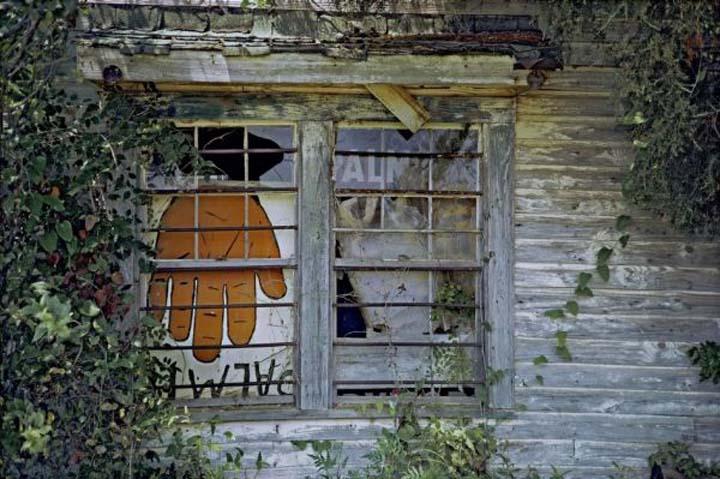William Christenberry: Keep Looking
The seemingly casual views of ordinary structures and almost featureless landscapes that comprise the photographic work of William Christenberry are anything but offhand. Paging through two books published by Aperture almost 25 years apart (Southern Photographs 1983) and William Christenberry (2006) offers an almost clairvoyant view of how this artist has approached his life-long subject: the landscape and the vernacular structures and signs of Hale County, Alabama.
The earlier book, published 20 years into his career, includes 35 or so of his Kodak Brownie pictures, so perfectly rendered regarding light, color and composition as to rival in importance their 8x10-inch variants. 5 Cent, Demopolis, Alabama, 1976 (above), is composed in a way that emphasizes the hand-lettered numeral painted on a weather-beaten brick wall, with vertical components of foliage and coursing serving the formal device of a picture frame. Two years later, Christenberry studies the same wall through the lens of an 8 x 10-inch view camera, to a completely different result. The same vertical course of brickwork holds the right side of the image while the more distant view draws the viewer’s attention to the cannibalistic foliage staking its claim on the sun-baked land—a precursor of the many takes of rampant kudzu devouring small buildings that fascinated Christenberry over the years [look].
One of the most often-visited structures in these collections is the Green Warehouse, Newbern, Alabama, which first appears in a 1973 Brownie. It begins as a highly formal composition celebrating a vernacular building typical to the region, which Christianberry visited year after year, transforming its angular, well-maintained surfaces in his painting and sculptures. It is one of the few buildings on his trail that somehow eluded the ravages of time and weather [look]
The iconic Palmist Building, Havana Junction (above), occupies a special place in the artist’s work, having once been a general store owned by an uncle. In the earlier book it appears four times times: in a 1971 Brownie; a 1980 large-format close-up of the window with palmist sign as well as a middle view from the same year; and a 1981 large-format view made in winter [look]. In the newer book, Site of the Palmist Building…,1988, depicts the building’s ultimate disappearance.
Unlike the common refrain from old-time Southern blues songs, “just passing through,” William Christenberry has revealed the subtleness of change through the passage of time and change of seasons with a persistence rewarded by his introspective sense of being. This approach rewards the viewer who keeps on looking—many times over.
Currently on view at Pace MacGill Gallery, with an opening reception Thursday, November 3rd from 6 to 8 pm, is William Christenberry: Summer | Winter. 32 East 57th Street, 9th Floor, NY, NY Info William Christenberry and Kodachromes/Photographs by William Christenberry are available from Aperture. CV19.FEAT.PHOTO PRreview




